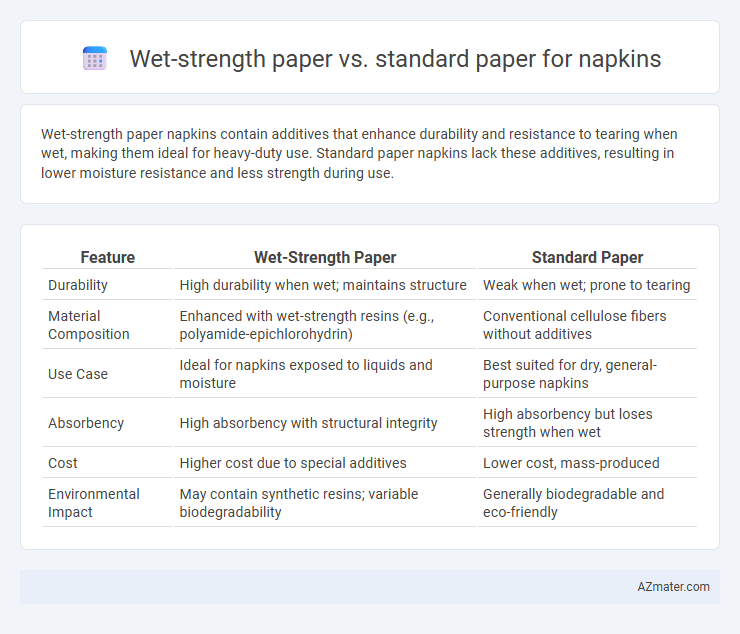Wet-strength paper napkins contain additives that enhance durability and resistance to tearing when wet, making them ideal for heavy-duty use. Standard paper napkins lack these additives, resulting in lower moisture resistance and less strength during use.
Table of Comparison
| Feature | Wet-Strength Paper | Standard Paper |
|---|---|---|
| Durability | High durability when wet; maintains structure | Weak when wet; prone to tearing |
| Material Composition | Enhanced with wet-strength resins (e.g., polyamide-epichlorohydrin) | Conventional cellulose fibers without additives |
| Use Case | Ideal for napkins exposed to liquids and moisture | Best suited for dry, general-purpose napkins |
| Absorbency | High absorbency with structural integrity | High absorbency but loses strength when wet |
| Cost | Higher cost due to special additives | Lower cost, mass-produced |
| Environmental Impact | May contain synthetic resins; variable biodegradability | Generally biodegradable and eco-friendly |
Introduction to Napkin Paper Types
Wet-strength paper for napkins is engineered with additives that enhance durability and resistance to moisture, making it ideal for use in environments where napkins frequently come into contact with liquids. Standard napkin paper, typically made from regular cellulose fibers, offers basic absorbency and softness but lacks the water resistance needed for heavy or prolonged use. Choosing between wet-strength and standard paper depends on the specific application, with wet-strength napkins preferred in restaurants and catering for their superior performance under moist conditions.
What is Wet-Strength Paper?
Wet-strength paper is specifically engineered to maintain its structural integrity when exposed to moisture, making it ideal for napkins used in wet or greasy conditions. It incorporates additives like synthetic resins or polymers that reinforce the paper fibers, preventing disintegration and enhancing durability compared to standard paper. This specialized paper is essential in applications requiring moisture resistance, ensuring napkins remain functional and intact during use.
Understanding Standard Paper for Napkins
Standard paper for napkins typically consists of cellulose fibers with limited wet-strength additives, making it less durable when exposed to moisture. It absorbs liquids quickly but tends to tear or disintegrate under wet conditions, reducing its effectiveness in handling spills. Manufacturers often use standard paper for everyday napkins where cost efficiency is prioritized over moisture resistance.
Key Differences: Wet-Strength vs Standard Paper
Wet-strength paper for napkins incorporates chemical additives that significantly enhance its durability and resistance to tearing when exposed to moisture, unlike standard paper which tends to weaken and disintegrate when wet. This essential difference makes wet-strength napkins ideal for use in environments with high moisture, such as restaurants or outdoor events, ensuring they maintain integrity during use. Standard paper napkins, while more cost-effective, are better suited for dry conditions where heavy absorbency and prolonged durability are less critical.
Absorbency and Performance Comparison
Wet-strength paper napkins exhibit superior absorbency compared to standard paper napkins due to their enhanced fiber bonding, which maintains structural integrity when exposed to moisture. These napkins resist tearing and disintegration during use, ensuring better performance for cleaning spills and wiping hands efficiently. Standard paper napkins tend to weaken quickly when wet, leading to reduced absorbency and lower durability during practical applications.
Durability in Wet Conditions
Wet-strength paper napkins exhibit superior durability in wet conditions due to enhanced bonding agents that prevent fiber disintegration, maintaining structural integrity longer than standard paper. Standard paper napkins tend to weaken and tear rapidly when exposed to moisture, limiting their effectiveness for spills and damp uses. The advanced formulation in wet-strength paper results in increased resistance to tearing and breakdown under wet environments, essential for reliable absorbency and durability.
Environmental Impact and Sustainability
Wet-strength paper for napkins is engineered to maintain integrity when exposed to moisture, reducing waste by minimizing product degradation during use, which supports sustainability efforts. Standard paper napkins, lacking enhanced durability, often require greater quantities per use, leading to higher resource consumption and increased environmental burden. Choosing wet-strength paper can contribute to waste reduction and more efficient resource utilization, aligning with eco-friendly practices and lowering overall environmental impact.
Cost Considerations and Value
Wet-strength paper for napkins involves higher material and manufacturing costs compared to standard paper due to added resins that enhance durability when moist. Despite the increased expense, wet-strength napkins offer greater value in environments requiring moisture resistance, reducing waste and improving user experience. Standard paper napkins remain cost-effective for low-moisture applications but may lead to higher replacement frequency, impacting long-term cost efficiency.
Ideal Uses for Wet-Strength Paper Napkins
Wet-strength paper napkins are designed to maintain durability and integrity when exposed to moisture, making them ideal for use in restaurants, catering events, and outdoor settings where spills and wet conditions are common. Their enhanced resistance to tearing and disintegration makes them suitable for handling greasy or oily foods, providing a more reliable and hygienic option compared to standard paper napkins. Wet-strength napkins are essential in environments where maintaining cleanliness and functionality under wet conditions is critical, such as in food service and hospitality industries.
Choosing the Right Napkin Paper for Your Needs
Wet-strength paper napkins offer superior durability and resistance to tearing when exposed to moisture, making them ideal for messy meals, outdoor events, or commercial food service settings. Standard paper napkins provide good absorbency and softness but tend to weaken quickly when wet, suited for light use or casual dining. Selecting the right napkin paper depends on factors like expected moisture exposure, budget constraints, and desired texture, with wet-strength options excelling in robustness and standard napkins favored for everyday convenience.

Infographic: Wet-strength paper vs Standard paper for Napkin
 azmater.com
azmater.com